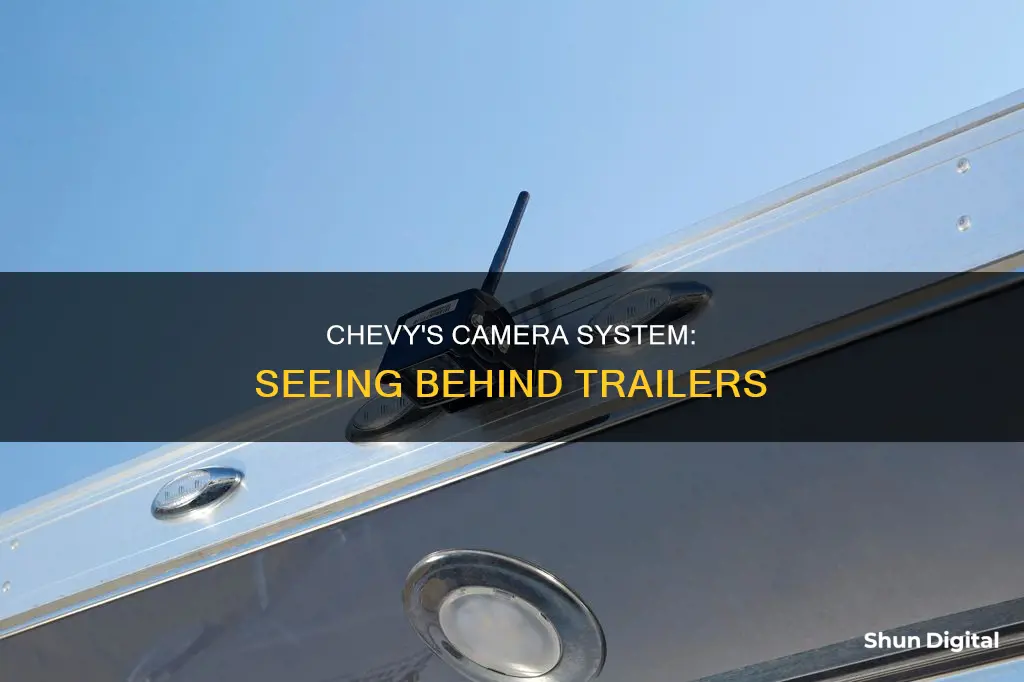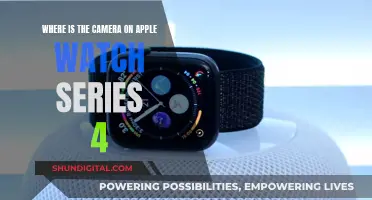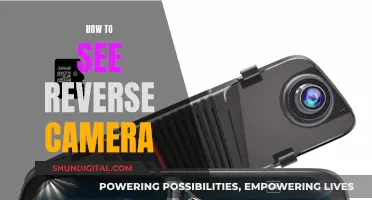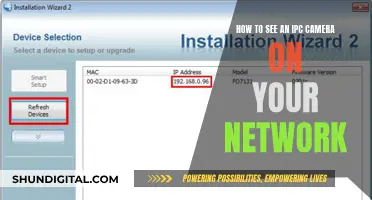
The Chevy Invisible Trailer Camera is an advanced technology that enhances visibility and safety while towing large objects. It employs a combination of strategically placed cameras and software algorithms to provide drivers with a clear view of their surroundings, including the area behind the trailer, which is usually out of sight. This innovative technology offers several benefits and features that improve the overall driving experience and promote road safety.
What You'll Learn

The Chevy Invisible Trailer Camera's purpose and benefits
The Chevy Invisible Trailer Camera is an innovative technology designed to enhance visibility and safety for drivers towing trailers, boats, or large vehicles. This advanced system employs a combination of strategically placed cameras and sophisticated software algorithms to provide drivers with a clear and comprehensive view of their surroundings, eliminating blind spots and improving situational awareness.
Purpose
The primary purpose of the Chevy Invisible Trailer Camera is to address the challenges of towing large trailers, boats, or vehicles by improving the driver's visibility and reducing blind spots. The system utilizes multiple high-definition cameras mounted on the vehicle and trailer to capture a 360-degree view of the surroundings, including the area directly behind the trailer, which is traditionally obscured from the driver's view.
Benefits
The benefits of the Chevy Invisible Trailer Camera are significant, offering enhanced safety, convenience, and improved maneuverability for drivers. Here are some of the key advantages:
- Improved Visibility and Safety: The system provides drivers with a clear view of their surroundings, including areas behind the trailer, reducing the risk of accidents, collisions, or damage to the vehicle, trailer, and surrounding property.
- Situational Awareness: By eliminating blind spots and providing a composite view of the vehicle and trailer's surroundings, the system enhances situational awareness, enabling drivers to make informed decisions and execute maneuvers with confidence.
- Ease of Use and Convenience: The camera system integrates seamlessly into select Chevy vehicles, offering intuitive controls and a user-friendly interface. The real-time monitoring features and visual aids, such as distance markers and trajectory lines, assist drivers in making precise maneuvers with confidence.
- Improved Maneuverability and Parking Assistance: With enhanced visibility and spatial awareness, drivers can more easily navigate tight spaces and crowded areas. The system's real-time monitoring and visual aids also help drivers maintain trailer alignment and reduce the risk of collisions or damage during parking maneuvers.
- Reduced Risk of Accidents: By providing a comprehensive view of the surroundings and potential obstacles, the camera system helps drivers navigate challenging driving conditions with ease and precision, ultimately reducing the likelihood of accidents and promoting road safety.
Infrared Cameras: Can They Detect Metal?
You may want to see also

How the camera system works
The Chevy Invisible Trailer Camera is an advanced technology that enhances visibility and safety when towing large vehicles like trailers, boats, or RVs. It does this by employing a combination of strategically placed cameras and software algorithms to provide drivers with a clear, composite view of their surroundings, including the area behind the trailer, which is usually obscured from view.
The camera system typically consists of multiple high-definition cameras positioned around the vehicle and trailer to capture a 360-degree view, eliminating blind spots. These cameras are mounted on the rear and sides of the vehicle, as well as the back of the trailer. The video streams from these cameras are then fed to a central processing unit, which combines and processes the images using advanced image processing techniques to create a seamless composite view. This composite view is then displayed on a monitor or touchscreen interface inside the vehicle's cabin, providing drivers with a comprehensive and real-time view of their surroundings.
The system offers various camera views, including the Transparent Trailer View, which allows drivers to "see through" their connected, compatible trailer. This view is achieved by using an existing camera on the tailgate handle and an accessory camera mounted on the back of the trailer. The system pieces together a view of the area behind the vehicle and trailer as if the trailer is invisible. The setup and calibration process involves measuring and entering the trailer's dimensions, installing the accessory camera, and driving forward in a straight line to confirm the entered dimensions.
The camera system also provides real-time monitoring features, allowing drivers to view a live video feed of their surroundings. This helps drivers make informed decisions, monitor potential obstacles, and execute maneuvers with precision and confidence. The system may also incorporate visual aids, such as distance markers, trajectory lines, and warning alerts, to further assist drivers in maneuvering, parking, and reversing safely.
Overall, the Chevy Invisible Trailer Camera improves situational awareness, enhances driving safety, and makes towing large vehicles more convenient and controlled, reducing the risk of accidents and collisions.
Hacking Smart TV Cameras: A Step-by-Step Guide
You may want to see also

Camera system limitations and challenges
While the Chevy Invisible Trailer Camera System offers significant benefits in terms of visibility and safety when towing, there are some limitations and challenges to be aware of.
Firstly, the system is susceptible to environmental factors that can affect visibility. Adverse weather conditions such as rain, fog, or snow can impair camera performance and reduce image clarity, making it more difficult for drivers to see their surroundings. Additionally, bright sunlight or glare may cause reflections or wash out the camera image, further hindering visibility. Drivers must remain vigilant and exercise caution when towing in less-than-ideal weather or lighting conditions, relying on other visual cues and mirrors to supplement the camera system.
Secondly, as with any technology, the Chevy Invisible Trailer Camera may experience technical glitches or malfunctions. Software bugs, hardware failures, or connectivity issues could disrupt the system's functionality, resulting in a loss of video feed or inaccurate image processing. To mitigate these risks, drivers should perform regular system checks and maintenance to ensure the camera is functioning correctly. It is also recommended that drivers familiarize themselves with alternative towing techniques and safety procedures in case of camera malfunction.
Another challenge is the learning curve associated with the technology. While the Chevy Invisible Trailer Camera is designed to be user-friendly, some drivers may need time to adjust to the system, especially if they are unfamiliar with such technology. Interpreting the camera's visual aids, adjusting to the interface, and integrating its features into their towing routine may require some practice and training. Chevy provides tutorials and demonstrations to help users overcome this challenge, and it is advised that drivers practice in controlled environments to build confidence and proficiency over time.
In conclusion, while the Chevy Invisible Trailer Camera System offers enhanced visibility and safety when towing, it is important to be aware of potential limitations and challenges. Environmental factors, technical issues, and a learning curve for new users are all considerations that drivers should keep in mind. However, through proper maintenance, training, and familiarity with the technology, these challenges can be effectively managed, ensuring a safer and more convenient towing experience.
Is It Safe to View an Eclipse Through a Camera?
You may want to see also

The setup and installation process
Step 1: Install the Accessory Trailer Camera
Firstly, you will need to mount the accessory trailer camera on the back of your trailer. The ideal position for the camera lens is centred on the back of the trailer, horizontally, and 4 inches higher than the tailgate camera on the back of your truck. It should be angled 35 degrees downward from the horizontal, and you can use the markings on the mounting unit to find this position. The camera should be no more than 8 inches away from this ideal position.
Step 2: Route and Secure the Wiring
Next, you will need to route and secure the wiring harness on the outside of the trailer. Refer to the camera installation instructions provided for guidance on routing the wires.
Step 3: Connect the Camera
Connect the camera to the connector at the trailer hitch, which is typically the rear trailer camera port.
Step 4: Enter Trailer Dimensions
Using the touchscreen on your truck's infotainment system, tap the trailering icon to access the trailer profile. Here, you will need to enter the exact dimensions of your compatible trailer. You will be prompted to enter seven measurements, including the centre of the coupler to the furthest rear point, the centre of the coupler to the middle of the tires, and the left edge to the right edge of the trailer. These measurements will help the system create an accurate composite view.
Step 5: Calibrate the Camera
The final step is calibrating the camera system. This process will confirm the dimensions you entered and create an accurate view of what's behind the trailer. Ensure the trailer is attached and your trailer profile is active, then simply drive forward in a straight line. The calibration will run in the background, and you can monitor its progress by tapping the camera app icon on your infotainment system's home screen. The distance you need to drive varies, and it may take several minutes. If you need to turn or speed up during calibration, the process will pause and then automatically resume once you straighten out and slow down.
Once calibration is complete, your Chevy Invisible Trailer Camera will be active and ready to use. You will not need to recalibrate unless you change the trailer dimensions.
Hotel Cameras: Privacy or Security?
You may want to see also

Other trailer safety features
Trailer safety is a critical aspect of towing, and various features and devices are available to enhance it. Here are some additional safety features to consider when towing a trailer:
- Backup cameras: Ford trucks, for instance, offer a backup camera option for trailers, providing visibility behind the trailer.
- Trailer backup sensors: These sensors outline the back edges of a trailer using data from the backup camera, assisting with manoeuvring and parking.
- Internal sensors for trailer wheels: This feature allows drivers to monitor the trailer's tire pressure and ensure optimal performance.
- Trailer sway control and traction control: These features help maintain the trailer's stability while driving, reducing the risk of losing control.
- Proper hitching: Understanding the proper hitch for the trailer and load is crucial. Safety chains should be correctly attached as a secondary measure in case the coupler fails.
- Weight distribution: Ensuring proper weight distribution in the trailer, both front-to-back and side-to-side, is vital for control and stability.
- Cargo securement: Improperly secured cargo can lead to weight redistribution and trailer sway. It is important to follow the trailer owner's manual for specific loading instructions.
- Trailer brakes: Efficient trailer brakes, such as electric or hydraulic brakes, are essential for safe and controlled stops. Disc brakes are preferred over drum brakes, which can overheat.
- Suspension: A good suspension system, such as torsion axles, helps absorb shock and provides a smoother ride, reducing the stress on the trailer and cargo.
- Trailer tires: Investing in quality tires rated for the specific loads being hauled is crucial. Radial tires are preferred over bias-ply tires for better handling at highway speeds. Regularly checking tire pressure is also important to prevent blowouts.
- Lighting: LED lights around the trailer's exterior improve visibility for the driver and other motorists. Ensure the trailer has brake lights, turn signals, and reflectors.
The Camera's Uncomfortable Eye: Why Do We Hate It?
You may want to see also
Frequently asked questions
The Chevy Invisible Trailer Camera is an advanced technology designed to improve visibility and safety when towing trailers, boats, or other large vehicles. It helps drivers make informed decisions and execute maneuvers with confidence, ultimately improving the towing experience and promoting road safety.
The Chevy Invisible Trailer Camera utilizes a network of strategically placed cameras mounted on the vehicle and trailer to capture live video footage of the surrounding environment. These cameras feed video streams to a central processing unit, which combines and processes the images to create a composite view of the vehicle and its surroundings. This composite view is then displayed on a monitor or touchscreen interface inside the vehicle, providing drivers with a comprehensive and real-time view of their surroundings, including the area behind the trailer.
The primary benefit of the Chevy Invisible Trailer Camera is improved visibility and safety while towing. It eliminates blind spots and provides drivers with a clear view of the road behind the trailer, reducing the risk of accidents, collisions, or damage to the vehicle, trailer, and surrounding property. The system also enhances situational awareness, enabling more confident maneuvering, especially when reversing, parking, or changing lanes.
To set up the Chevy Invisible Trailer Camera, you will need a properly equipped truck, a compatible trailer, and the necessary tools to install the accessory camera. The steps include installing the accessory trailer camera in the specified location on the back of the trailer, entering the trailer's dimensions into the Trailer Profile on the infotainment system or mobile app, and then calibrating the system by driving forward in a straight line.
While the Chevy Invisible Trailer Camera significantly enhances visibility and safety, it is not without limitations. Environmental factors such as adverse weather conditions or bright sunlight can affect camera performance and reduce image clarity. Additionally, as with any technology, there is a potential for technical glitches or malfunctions that could disrupt the system's functionality. It is important for drivers to remain vigilant and familiar with alternative towing techniques and safety procedures.







